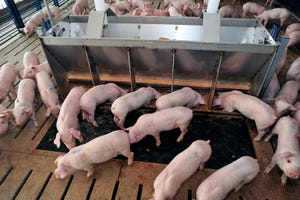Plan to survive, so you can thrive
Many producers have seen non-feed expenses increase by approximately 40% from their pre-pandemic levels.
October 18, 2023

By Nic Rue, Compeer Financial
Pork producers, known for their resilience and determination, have faced a challenging year in 2023. Many have encountered losses not seen since 1998 due to market volatility and high input prices.
In such difficult times, it’s natural for producers and those supporting them to feel discouraged and question the future. However, it’s essential to remember that a vibrant U.S. pork industry will emerge from these challenging times. To ensure survival and future prosperity, we must take control of our situation and plan for the road ahead.
First, it’s crucial to assess your current situation, clear your mind and reaffirm your commitment to the business. Determine if you or the next generation still have the passion and dedication required for this industry, along with the physical health to execute your business plan.
Do you still look forward to tending to your animals and doing what you love? If so, it’s time to create a financial roadmap for the future, involving trusted advisors like your nutritionist, risk management specialist and yes, even your lender. While some already follow this practice, some do it halfheartedly, and others don’t at all.
Your financial plan should be comprehensive, considering various stress scenarios, and should be regularly updated, especially during in times of volatility. Ensure it accounts for the current price environment for all inputs, not just feed costs. Many producers have seen non-feed expenses increase by approximately 40% from their pre-pandemic levels. Test your projection by introducing potential health challenges, allowing you to understand the financial impact and be prepare to respond swiftly.
Lastly, compare your projection with your existing financial position to ensure you have the necessary liquidity to operate your business, even during times of stress. As of our June 30, 2023 benchmarks, the average producer had a working capital per sow of $795, a reduction from the previous year-end figure of $1,138, and a year-over-year decrease of $452 compared to June 30, 2022. Remember that this is the average, and some producers may have more or less working capital.
While reduced working capital still allows for day-to-day business operations, it indicates that we can bear less risk as an industry than we could a year ago. If you have limited liquidity, consider steps to minimize risk in the market or elsewhere.
When assessing your financial position, be sure to incorporate stress scenarios to cover your bases. If there’s a risk of liquidity shortfall, explore options such as leveraging existing hog facilities or unencumbered crop ground, contributing capital or increasing your line of credit.
As of the date of this article (Oct. 16), current futures projections indicate potential losses of $7 to $40 per head between now and the year’s end, with break-even profitability levels expected in FY 2024. Work closely with your management team and trusted advisors to develop a plan tailored to your unique operating and financial situation.
Tough times are temporary. With a well-thought-out plan, tough producers will endure and prosper.
Rue is vice president, swine lending at Compeer Financial. For more insights from Rue and the Compeer Swine Team, visit Compeer.com.
You May Also Like



